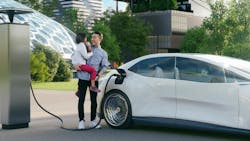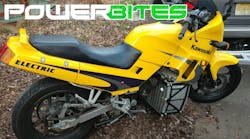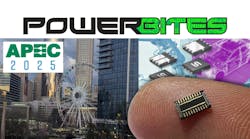Energy-Efficient IGBTs and RC-IGBTs Target 400/800-V EV Systems
Responding to the growing demand for high-voltage automotive IGBT chips, Infineon Technologies developed a new generation of products: the EDT3 (Electric Drive Train, 3rd generation) chips designed for 400- and 800-V systems, and its RC-IGBT chips tailored specifically for 800-V systems. Both devices are available as bare dies, making it easier for customers to create custom power modules.
Created to enhance the performance and reliability of electric drivetrain systems, the EDT3’s structure was optimized to minimize chip losses and increase the maximum junction temperature to balance high-load performance and low-load efficiency. As a result, it’s able to achieve up to 20% lower total losses at high loads (versus the EDT2) while maintaining efficiency at low loads.
The EDT3 devices, available in 750- and 1,200-V classes, can sustain a maximum virtual junction temperature of 185°C. This makes it possible for automakers to design more efficient and reliable powertrains that can help extend an EV’s range or reduce its battery capacity requirements.
The 1,200-V RC-IGBT achieves higher performance by integrating IGBT and diode functions on a single die for even higher current density compared to separate IGBT and diode chipset solutions. Infineon’s latest EDT3 IGBT chip technology is now integrated into the HybridPACK Drive G2 automotive power-module family, which offers a power range of up to 250 kW.
Both device families can be ordered with customized chip layouts, including on-chip temperature and current sensors. In addition, metallization options for sintering, soldering, and bonding are available on request. The new EDT3 and RC-IGBT devices are already available for sampling. Further information can be found here.
Next in This Edition of PowerBites
More PowerBites
About the Author
Lee Goldberg
Contributing Editor
Lee Goldberg is a self-identified “Recovering Engineer,” Maker/Hacker, Green-Tech Maven, Aviator, Gadfly, and Geek Dad. He spent the first 18 years of his career helping design microprocessors, embedded systems, renewable energy applications, and the occasional interplanetary spacecraft. After trading his ‘scope and soldering iron for a keyboard and a second career as a tech journalist, he’s spent the next two decades at several print and online engineering publications.
Lee’s current focus is power electronics, especially the technologies involved with energy efficiency, energy management, and renewable energy. This dovetails with his coverage of sustainable technologies and various environmental and social issues within the engineering community that he began in 1996. Lee also covers 3D printers, open-source hardware, and other Maker/Hacker technologies.
Lee holds a BSEE in Electrical Engineering from Thomas Edison College, and participated in a colloquium on technology, society, and the environment at Goddard College’s Institute for Social Ecology. His book, “Green Electronics/Green Bottom Line - A Commonsense Guide To Environmentally Responsible Engineering and Management,” was published by Newnes Press.
Lee, his wife Catherine, and his daughter Anwyn currently reside in the outskirts of Princeton N.J., where they masquerade as a typical suburban family.
Lee also writes the regular PowerBites series.





